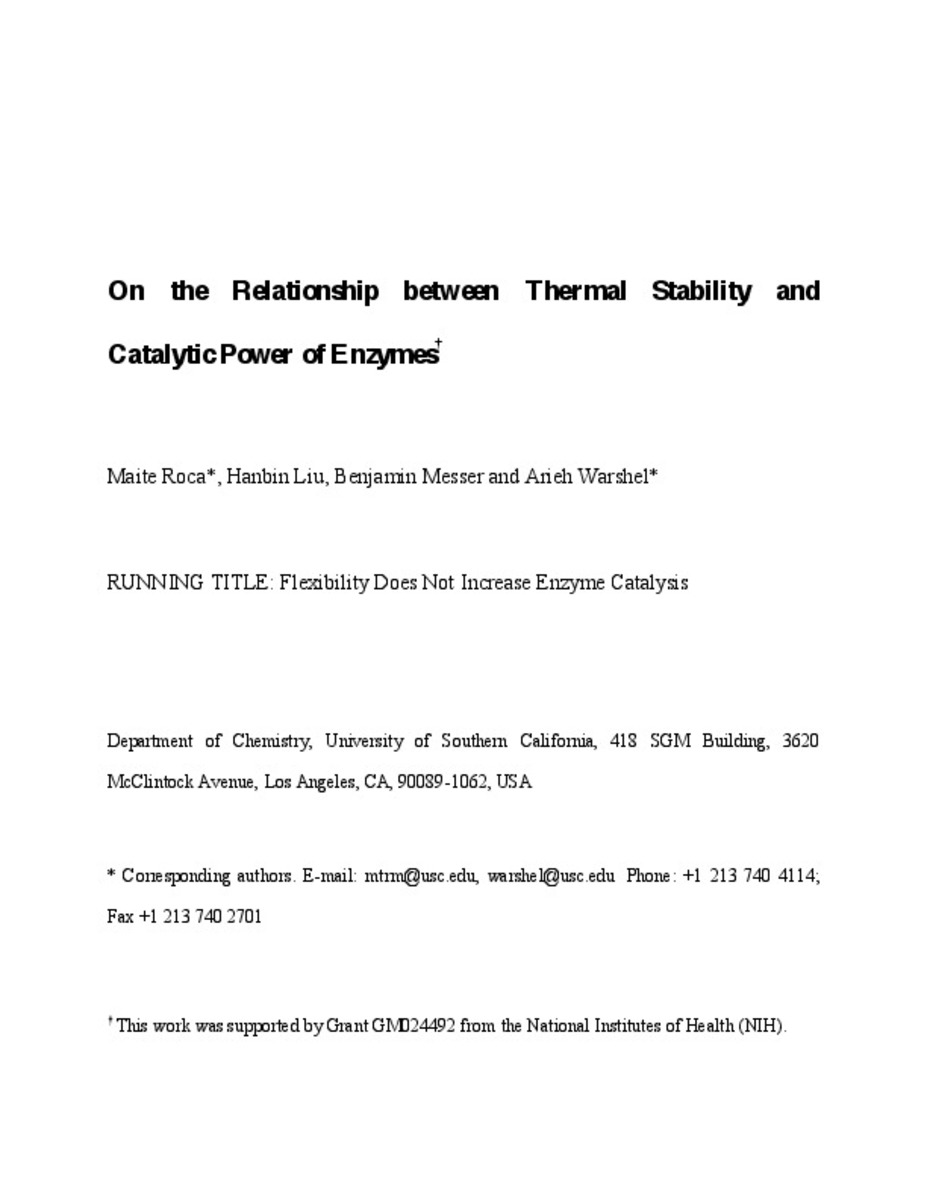| dc.contributor.author | Roca, Maite | |
| dc.contributor.author | Liu, Hanbin | |
| dc.contributor.author | Messer, Benjamin | |
| dc.contributor.author | Warshel, Arieh | |
| dc.date.accessioned | 2016-05-10T07:47:24Z | |
| dc.date.available | 2016-05-10T07:47:24Z | |
| dc.date.issued | 2007-12-25 | |
| dc.identifier.citation | ROCA MOLINER, María Teresa; LIU, Hanbin; MESSER, Benjamin; WARSHEL, Arieh. On the relationship between thermal stability and catalytic power of enzymes. Biochemistry (2007), v. 46, issue 51, pp. 15076-15088, | ca_CA |
| dc.identifier.uri | http://hdl.handle.net/10234/159458 | |
| dc.description.abstract | The possible relationship between the thermal stability and the catalytic power of enzymes is of great current interest. In particular, it has been suggested that thermophilic or hyperthermophilic (Tm) enzymes have lower catalytic power at a given temperature than the corresponding mesophilic (Ms) enzymes, because the thermophilic enzymes are less flexible (assuming that flexibility and catalysis are directly correlated). These suggestions presume that the reduced dynamics of the thermophilic enzymes is the reason for their reduced catalytic power. The present paper takes the specific case of dihydrofolate reductase (DHFR) and explores the validity of the above argument by simulation approaches. It is found that the Tm enzymes have restricted motions in the direction of the folding coordinate, but this is not relevant to the chemical process, since the motions along the reaction coordinate are perpendicular to the folding motions. Moreover, it is shown that the rate of the chemical reaction is determined by the activation barrier and the corresponding reorganization energy, rather than by dynamics or flexibility in the ground state. In fact, as far as flexibility is concerned, we conclude that the displacement along the reaction coordinate is larger in the Tm enzyme than in the Ms enzyme and that the general trend in enzyme catalysis is that the best catalyst involves less motion during the reaction than the less optimal catalyst. The relationship between thermal stability and catalysis appears to reflect the fact that in order to obtain small electrostatic reorganization energy it is necessary to invest some folding energy in the overall preorganization process. Thus, the optimized catalysts are less stable. This trend is clearly observed in the DHFR case. | ca_CA |
| dc.format.extent | 55 p. | ca_CA |
| dc.format.mimetype | application/pdf | ca_CA |
| dc.language.iso | eng | ca_CA |
| dc.publisher | ACS Publications | ca_CA |
| dc.relation.isPartOf | Biochemistry (2007), v. 46, issue 51 | ca_CA |
| dc.rights.uri | http://rightsstatements.org/vocab/CNE/1.0/ | * |
| dc.subject | Thermal stability | ca_CA |
| dc.subject | Enzymes | ca_CA |
| dc.subject | Catalytic power | ca_CA |
| dc.subject | Dynamics | ca_CA |
| dc.subject | Dihydrofolate reductase (DHFR) | ca_CA |
| dc.title | On the relationship between thermal stability and catalytic power of enzymes | ca_CA |
| dc.type | info:eu-repo/semantics/article | ca_CA |
| dc.identifier.doi | http://dx.doi.org/10.1021/bi701732a | |
| dc.rights.accessRights | info:eu-repo/semantics/openAccess | ca_CA |
| dc.relation.publisherVersion | http://pubs.acs.org/doi/abs/10.1021/bi701732a | ca_CA |
| dc.edition | Preprint | ca_CA |
| dc.type.version | info:eu-repo/semantics/publishedVersion | ca_CA |







